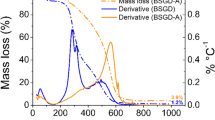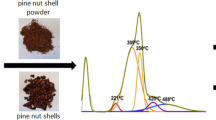Abstract
The study is devoted to the characterization by both TG-DTG analysis and FTIR spectroscopy of beech flour, dyes and the sorbent-dyes products obtained through retention of the dyes from aqueous solution on the beech flour, to the aim of obtaining information on the nature of dyes’ retention, thermal behavior of the sorbent-dye materials as well as on their possible upgrading as fuel.
Thermal analysis led to the conclusion that the mechanism of thermo-oxidative degradation is specific and the retention of dyes occurs on cellulose from beech flour. The nature of the bonds involved in dyes’ retention is also investigated by FTIR analysis, which evidences that dyes retention on cellulose is realized through hydrogen bonding between the NH and, respectively, OH groups from dye molecule and the oxygen atoms from cellulose. Involvement of the non-participating electrons of the nitrogen and, respectively, oxygen atoms of these groups in the extended electronic conjugation with aromatic nuclei strongly influences the capacity of the amino and, respectively, hydroxyl groups of forming hydrogen bonds, thus achieving dyes fixation on the sorbent. DTA analysis led to the conclusion that an improvement in the quality of the sorbent-dye materials as fuels is possible, as compared to untreated beach flour, as a result of the modification of the cellulosic fibers in the process of dyes retention.
Similar content being viewed by others
References
D. L. Michelsen, L. I. Fulk, R. M. Woodby and G. D. Boardman, Emerging Technologies in Hazardous Waste Management III, D. W. Tedder and F. G. Pohland Ed., Washington D.C. 1993.
A. Bertea and R. Butnaru, Aspecte ecologice si toxicologice ale finisării chimice textile, Dosoftei, Iaşi 1997.
P. Cooper, J. Soc. Dyers Colour, 109 (1993) 97.
R. S. Shukla and V. D. Sachardande, J. Appl. Polym. Sci., 42 (1991) 829.
V. K. Garg, R. Gupta, A. B. Yadav and R. Kumar, Biores. Technol., 89 (2003) 121.
V. K. Gupta, I. Ali, S. Mohan and D. Mohan, J. Colloid Interface Sci., 265 (2003) 257.
V. J. Poots, G. McKay and J. J. Healy, Water Res., 10 (1976) 1067.
Y. S. Ho and G. McKay, Chem. Eng. J., 70 (1998) 115.
W. Wardas and J. Lebek, Cellulose Chem. Technol., 28 (1994) 255.
C. Namasivayam, M. Dinesh Kumar, K. Selvi, R. Ashruffunissa Begum, T. Vanathi and R. T. Yamuna, Biomass Bioenergy, 21 (2001) 477.
F. Banat, S. Al-Asheh and L. Al-Makadahmeh, Proc. Biochem., 39 (2003) 193.
S. Stefanicich, F. Delben and R. A. A. Muzzarelly, Carbohydr. Polym., 24 (1994) 17.
L. C. Morais, O. M. Freitas, E. P. Goncalves, L. T. Vasconcelos and G. G. Ganzales Beca, Water Res., 21 (1987) 1513.
Z. Yermiyahu, A. Landau, A. Zaban, I. Lapides and S. Yariv, J. Therm. Anal. Cal., 72 (2003) 431.
M. Epstein, I. Lapides and S. Yariv, J. Therm. Anal. Cal., 82 (2005) 585.
G. Rytwo, R. Huterer-Harari, S. Dultz and Y. Gonen, J. Therm. Anal. Cal., 84 (2006) 225.
A. Landau, A. Zaban, I. Lapides and S. Yariv, J. Therm. Anal. Cal., 70 (2002) 103.
V. Dulman, S. Cucu-Man and V. I. Popa, Cellulose Chem. Technol., 36 (2002) 515.
V. Dulman, S. Cucu-Man and V. I. Popa, J. Balkan Ecology, 5 (2002) 94.
V. Dulman, L. Odochian, M. Dumitraş and S. Cucu-Man, J. Serb. Chem. Soc., 70 (2005) 1325.
V. Dulman, S. Cucu-Man, V. I. Popa and R. Mureşan, An. St. Univ. ‘Al. I. Cuza’ Iasi, Seria Chimie, VII (2000) 245.
V. Dulman, L. Odochian and M. Dumitraş, 13rd Annual Symposium of Scientific Communications, Romanian Academy, Thermal Analysis and Calorimetry Committee, Bucharest, February 2004.
M. Macoveanu, F. Ciobanu, E. Costea, G. Cazacu and C. Vasile, Cellulose Chem. Technol., 318 (1997) 361.
C. Simionescu, M. Grigoraş, A. Cernătescu Asandei and Gh. Rozamarin, The Chemistry of Romanian Wood, Romanian Academy, Bucharest 1973, p. 132.
M. Avram and G. D. Mateescu, Infrared Spectroscopy: Applications in Organic Chemistry, Krieger Publishing, Huntington, NY 1978.
Author information
Authors and Affiliations
Corresponding author
Rights and permissions
About this article
Cite this article
Odochian, L., Dulman, V., Dumitraş, M. et al. Study by thermal methods on the materials obtained by dye removal from waste waters with beech flour. J Therm Anal Calorim 89, 625–631 (2007). https://doi.org/10.1007/s10973-006-7619-x
Received:
Accepted:
Published:
Issue Date:
DOI: https://doi.org/10.1007/s10973-006-7619-x




